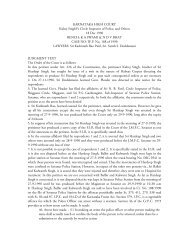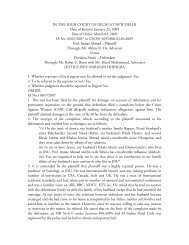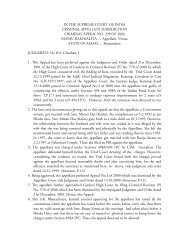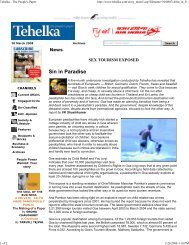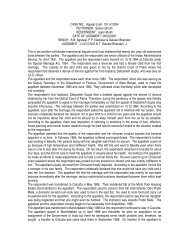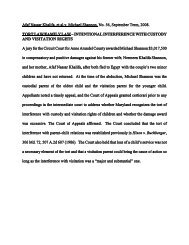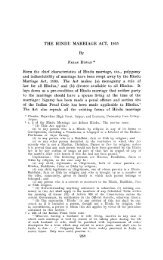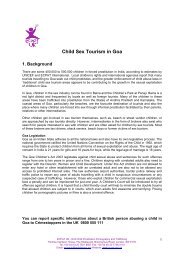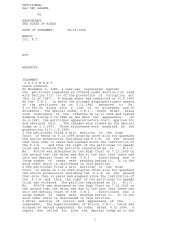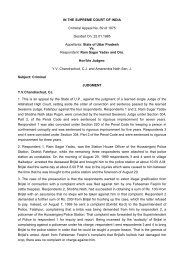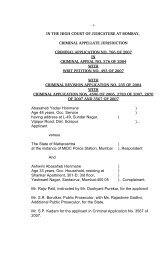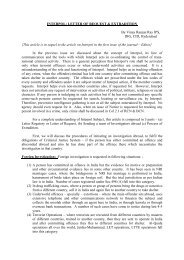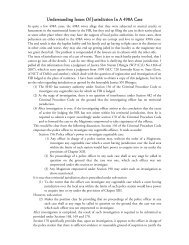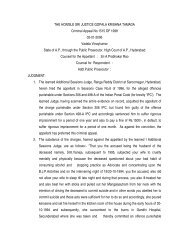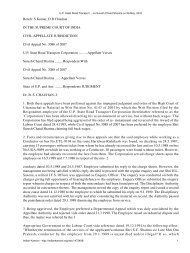CASE NO.: Writ Petition (civil) 265 of 2006 PETITIONER ... - IPC 498A
CASE NO.: Writ Petition (civil) 265 of 2006 PETITIONER ... - IPC 498A
CASE NO.: Writ Petition (civil) 265 of 2006 PETITIONER ... - IPC 498A
Create successful ePaper yourself
Turn your PDF publications into a flip-book with our unique Google optimized e-Paper software.
<strong>CASE</strong> <strong>NO</strong>.:<br />
<strong>Writ</strong> <strong>Petition</strong> (<strong>civil</strong>) <strong>265</strong> <strong>of</strong> <strong>2006</strong><br />
<strong>PETITIONER</strong>:<br />
Ashoka Kumar Thakur<br />
RESPONDENT:<br />
Union <strong>of</strong> India and Ors<br />
DATE OF JUDGMENT: 29/03/2007<br />
BENCH:<br />
Dr. ARIJIT PASAYAT & LOKESHWAR SINGH PANTA<br />
JUDGMENT:<br />
J U D G M E N T<br />
I.A. No.13<br />
IN<br />
WRIT PETITION (CIVIL) <strong>NO</strong>. <strong>265</strong> OF <strong>2006</strong><br />
(With WP (Civil) Nos. 269/<strong>2006</strong>, 598/<strong>2006</strong>, 35/2007 and 29/2007)<br />
Dr. ARIJIT PASAYAT, J.<br />
In this I.A. prayer has been made to grant interim<br />
protection pending final disposal <strong>of</strong> the writ petitions.<br />
In the writ petitions the policy <strong>of</strong> 27% reservation for<br />
the Other Backward Classes (in short the 'OBCs') contained<br />
in the Central Educational Institutions (Reservation in<br />
Admission) Act, <strong>2006</strong> (in short the 'Act') is the subject<br />
matter <strong>of</strong> challenge. The primary ground <strong>of</strong> challenge is<br />
that the Union <strong>of</strong> India has failed in performing the
constitutional and legal duties toward the citizenry and its<br />
resultant effect. Consequentially the Act shall have the<br />
effect and wide ramifications and ultimately it shall have<br />
the result in dividing the country on caste basis. It would<br />
lead to chaos, confusion, and anarchy which would have<br />
destructive impact on the peaceful atmosphere in the<br />
educational and other institutions and would seriously<br />
affect social and communal harmony. The constitutional<br />
guarantee <strong>of</strong> equality and equal opportunity shall be<br />
seriously prejudiced. It has been contended that a time<br />
has come to replace the "vote bank" scenario with "talent<br />
bank". The statute in question, it is contended, has lost<br />
sight <strong>of</strong> the social catastrophe it is likely to unleash. Not<br />
only the products would be intellectual pigmies as<br />
compared to normal intellectual sound students presently<br />
passing out. It has been highlighted that on the basis <strong>of</strong><br />
unfounded and unsupportable data about the number <strong>of</strong><br />
OBCs in the country the Act has been enacted. It has been<br />
pointed out that this Court in Indra Sawhney v. Union <strong>of</strong><br />
India and Ors. (1992 Supp. (3) SCC 217) had recognised<br />
the concept <strong>of</strong> "creamy layer" amongst the advanced OBCs<br />
to be kept out <strong>of</strong> preferential treatment. The population<br />
data <strong>of</strong> 52% projected by the Mandal Commission was not<br />
actually given the seal <strong>of</strong> acceptance. In any event, this<br />
Court in its judgment dated 16.11.1992 directed the<br />
Government to constitute a permanent body by 15th March,<br />
1993 for examining and recommending for inclusion or<br />
exclusion in the lists <strong>of</strong> backward classes <strong>of</strong> citizens. The<br />
National Commission for Backward Classes Act, 1993 (in<br />
short the 'Backward Classes Act') defines 'backward<br />
classes" to mean such backward classes <strong>of</strong> citizens other<br />
than the Scheduled Castes and Scheduled Tribes as may<br />
be specified by the Central Government in the lists. In<br />
terms <strong>of</strong> Section 2(c) <strong>of</strong> the Act "lists" mean lists prepared
y the Government <strong>of</strong> India from time to time for the<br />
purpose <strong>of</strong> making provision for the reservation <strong>of</strong><br />
appointments or posts in favour <strong>of</strong> backward classes <strong>of</strong><br />
citizens which in the opinion <strong>of</strong> the Government are not<br />
adequately represented in the services under the<br />
Government <strong>of</strong> India and any legal or other authority within<br />
the territory <strong>of</strong> India or under the control <strong>of</strong> the<br />
Government <strong>of</strong> India. Though there is a specific provision in<br />
Section 11 <strong>of</strong> the Backward Classes Act for a periodic<br />
revision <strong>of</strong> the lists, same has not been done, and on the<br />
contrary additions are being made. The rational <strong>of</strong> 27%<br />
having been arrived at on the mythical figure that the<br />
OBCs are 52% in the country and even the ratio <strong>of</strong> 27%<br />
reservation for the students belonging to other backward<br />
classes in the educational institutions is to be funded and<br />
controlled by the Central Government. The same is to be<br />
enforced from May 2007. It is highlighted that after 1931<br />
census there has never been any caste-wise enumeration or<br />
tabulation which in essence corrodes the credibility <strong>of</strong> the<br />
claim <strong>of</strong> 52% population <strong>of</strong> other backward classes.<br />
It is pointed out that in terms <strong>of</strong> Section 2(g), 3(iii),<br />
Sections 5(1)(2) and 6 <strong>of</strong> the Act, 27% seats are being<br />
reserved for other backward classes out <strong>of</strong> only permitted<br />
strength. The expression "Other Backward Classes" means<br />
the class or classes <strong>of</strong> citizens who are socially or<br />
educationally backward and are so determined by the<br />
Central Government. There has never been any<br />
determination on any acceptable basis. The parameters<br />
provided in the Backward Classes Act have not been kept<br />
in view. Without supportable data the introduction <strong>of</strong> a<br />
Statute which would have the effect <strong>of</strong> disturbing the<br />
harmony in the society was avoidable. Though it has been<br />
provided that increase in the number <strong>of</strong> seats can be done
in a staggered manner, that is really <strong>of</strong> no consequence.<br />
The stand that number <strong>of</strong> seats available for the general<br />
categories remains unaffected is really not a solution as in<br />
essence unequals are treated as equals. The very concept <strong>of</strong><br />
equality enshrined in Article 14 <strong>of</strong> the Constitution <strong>of</strong> India,<br />
1950 (in short the 'Constitution') is directly affected.<br />
Reference is made to the figures provided by the<br />
National Samples Survey <strong>of</strong> India and the National Health<br />
and Family Survey (Government <strong>of</strong> India's own<br />
Departments) which clearly establish the hollowness <strong>of</strong> the<br />
claim about OBCs being 52% <strong>of</strong> the population. The source<br />
for the enactment <strong>of</strong> the Act was the 93rd amendment to the<br />
Constitution which has come into force w.e.f. 20.1.<strong>2006</strong> by<br />
insertion <strong>of</strong> Clause (5) in Article 15 <strong>of</strong> the Constitution.<br />
Prayer has been made to declare certain provisions in<br />
the Act to be unconstitutional.<br />
The effect <strong>of</strong> the judgments in M. Nagaraj and Ors. v.<br />
Union <strong>of</strong> India and Ors. (<strong>2006</strong> (8) SCC 212) and Nair<br />
Service Society v. State <strong>of</strong> Kerala (<strong>Writ</strong> <strong>Petition</strong> (Civil) No.<br />
598 <strong>of</strong> 2000 etc. decided on 23.02.2007) has not been<br />
considered. It has been emphasized that what may have<br />
been relevant eight decades back cannot hold good in the<br />
present scenario. There has to be indepth analysis to find<br />
out the number <strong>of</strong> socially and educationally backward<br />
class <strong>of</strong> citizens. The concept <strong>of</strong> Backward class citizens is<br />
dealt with in para 786 <strong>of</strong> Indra Sawhney's case (supra). It is<br />
pointed out that in the immediately succeeding paragraph<br />
i.e. Paragraph 787 the position has been clarified. In that<br />
paragraph reference has also been made at page 720 that<br />
certain classes which may not qualify for Article 15(4) may<br />
qualify for Article 16(4). Reference is made to Janki Prasad
Parimoo v. State <strong>of</strong> J & K (1973 (1) SCC 420) to contend<br />
that it is social and educational backwardness <strong>of</strong> a class<br />
which is material for the purposes <strong>of</strong> Articles 16(4). It does<br />
not have determinative relevance for the purposes <strong>of</strong><br />
Articles 15(4) and 15(5). Further reference is also made to<br />
the concluding para 859 in Indra Sawhney's case (supra)<br />
where it has been said in category (3)(c) that it is not<br />
correct to say that backward class <strong>of</strong> citizens contemplated<br />
in Article 16(4) is the same as the socially and<br />
educationally backward classes referred to in Article 15(4).<br />
It is much wider. Therefore, it is submitted that the concept<br />
<strong>of</strong> socially and educationally backward classes in Article<br />
15(4) stand on a different footing from Article 16(4) and<br />
consequentially Article 15(5) is different from Article 16(4).<br />
It has been highlighted that in any event the concept<br />
<strong>of</strong> creamy layer which has been completely kept out <strong>of</strong><br />
consideration in the Statute has great relevance and effect.<br />
The criteria <strong>of</strong> Article 16(4) and the lists under the<br />
Backward Classes Act can at the most provide a rough and<br />
ready rule for the purpose <strong>of</strong> Articles 15(4) and 15(5) but<br />
that does not in any way take care <strong>of</strong> the requirements <strong>of</strong><br />
Section 11 <strong>of</strong> the Backward Classes Act. There is no report<br />
subsequent to 3.2.2005 by the National Commission for the<br />
Backward Classes. Therefore, it is highlighted that the<br />
whole exercise has been done in great hurry without any<br />
justifiable reason. Since there is no data base after 1931<br />
census, what the Government could have done is to find<br />
out a definite data base and then take such action as is<br />
permissible in law. Even otherwise, the Office<br />
Memorandum bearing No.36012/31/90-Est.(SCT) dated<br />
13.8.1990 on which great emphasis has been laid by<br />
learned Additional Solicitor General for the respondent-<br />
Union <strong>of</strong> India, does not take note <strong>of</strong> another
O.M.No.36012/22/93-Estt.(SCT) dated 8.9.1993 which<br />
expressly states as follows:<br />
"(d) The OBCs for the purpose <strong>of</strong> the<br />
aforesaid reservation would comprise, in<br />
the first phase, the castes and communities<br />
which are common to both the lists in the<br />
report <strong>of</strong> the Mandal Commission and the<br />
State Governments' Lists. A list <strong>of</strong> such<br />
castes and communities is being issued<br />
separately by the Ministry <strong>of</strong> Welfare."<br />
It has been pointed out that the Act itself specifically<br />
requires a determination <strong>of</strong> socially and educationally<br />
backward classes to be made by the Central Government,<br />
as is clear from a bare reading <strong>of</strong> Section 2(g). That has not<br />
been done for the purposes <strong>of</strong> the Act and by referring to<br />
the lists meant for cases covered by Article 16(4) the<br />
requirements have not been met, there cannot be any basis<br />
for contending that the "creamy layer concept" attached to<br />
Article 16(4) has no relevance for Articles 15(4) and 15(5). It<br />
is pointed out that the intention <strong>of</strong> the Parliament does not<br />
appear to be that any existing list under Article 16(4)<br />
should be treated as the foundation for Section 2(g) <strong>of</strong> the<br />
Act. The determination should be made "in futuro" and not<br />
by adopting any past determination by the National<br />
Commission for the purposes <strong>of</strong> Article 15(5). The "special<br />
provision <strong>of</strong> law" under Article 15(5) is the Act which<br />
provides that OBCs must be so determined for the<br />
purposes <strong>of</strong> the Act by the Central Government (underlined<br />
for emphasis). There has been no separate determination.<br />
In essence, it is submitted that the baseless figure <strong>of</strong>
27% cannot be pressed into service for introducing a<br />
Statute which has such wide ramifications. No methodology<br />
has been laid down for determining the socially and<br />
educationally backward classes because castes alone<br />
should not be made the basis for identification even though<br />
there appears to be some casual observations in Indra<br />
Sawhney's case (supra) as contended by learned Additional<br />
Solicitor General that castes can be synonyms with class.<br />
That is not the correct approach. It was only stated that<br />
castes may be the starting point for identifying the<br />
backward class, but it can not definitely be the sole basis.<br />
The figure <strong>of</strong> 27% it is emphasized is an imaginary<br />
figure with no rational. The non exclusion <strong>of</strong> "creamy layer"<br />
has also affected the validity <strong>of</strong> the Statute.<br />
In addition to these aspects highlighted by Mr. F.S.<br />
Nariman, Senior Advocate, Mr. P.P. Rao, Senior Advocate,<br />
Mr. M.L. Lahoti, Advocate, Mr. Sushil Kr. Jain, Advocate,<br />
Mr. V. Tankha, Senior Advocate, Mr. Ashoka Kr. Thakur<br />
and Dr. Mittal, who appear in person, have more or less<br />
highlighted to similar effect.<br />
Mr. P.P. Rao, Senior Advocate, with reference to<br />
certain observations in Indra Sawhney's case (supra) has<br />
submitted that inclusion <strong>of</strong> castes in the lists <strong>of</strong> backward<br />
classes cannot be mechanic and cannot be done without<br />
adequate relevant data.<br />
The following reports have also been referred to<br />
highlight as to how figures arrived at by the Union are<br />
erroneous.<br />
"(a) The National Sample Survey
Organisation survey <strong>of</strong> 1999-2000 which<br />
shows that the present educational level is<br />
directly proportionate to his/her economic<br />
condition. (pp. 14-15 para 7.21, 7.22 and<br />
7.23)<br />
(b) Section 11 <strong>of</strong> the National Commission<br />
for Backward Classes Act, 1993 which says<br />
"The Central Government may at any time,<br />
and shall, at the expiration <strong>of</strong> ten years<br />
from the coming into force <strong>of</strong> this Act and<br />
every succeeding period <strong>of</strong> ten years<br />
thereafter, undertake revision <strong>of</strong> the lists<br />
with a view to excluding from such lists<br />
those classes who have ceased to be<br />
backward classes or for including in such<br />
lists new backward classes.<br />
(c) Standing Committee on Social Justice<br />
and Empowerment Chaired by Sumitra<br />
Mahajan 2005-<strong>2006</strong> (pp 18-22 - Copy <strong>of</strong><br />
the Report is Annexure P-lI in Vol.II at<br />
pp.142-217).<br />
(d) 186th Report <strong>of</strong> the Parliamentary<br />
Standing Committee <strong>of</strong> Human Resources<br />
Development submitted to the Parliament<br />
on 1-12-<strong>2006</strong> (pp. 22-23 paras 8.8 to 8.13).<br />
The Report is Annexure P-Ill in Vol.II at<br />
pp.218-227).<br />
(e) Annual Report <strong>of</strong> National Commission<br />
for Backward Classes dt. 3-2-2005. (Para<br />
8.14 at pp 25-26). The Report is Annexure
P-IV in Vol.II at pp. 228-317.<br />
(f) Report <strong>of</strong> the Oversight Committee<br />
constituted under the Orders <strong>of</strong> the Prime<br />
Minister on 27-5-<strong>2006</strong> (pp. 29-30 para 8.19<br />
to 8.21). The Report is Annexure P-V in<br />
Vol.II at pp 318-353."<br />
It is pointed out that Office Memoranda <strong>of</strong> 1990 and<br />
1991 referred to in Indra Sawhney's case (supra) cannot<br />
hold the field forever. It is pointed out that if that continues<br />
to be so, Section 11 <strong>of</strong> the Backward Classes Act would be<br />
rendered nugatory. The revision <strong>of</strong> the lists was called for<br />
after expiration <strong>of</strong> the period <strong>of</strong> 10 years. The non-revision<br />
renders the acceptability <strong>of</strong> the figures doubtful and<br />
basisless.<br />
In Mandal Commission's Report it was inter-alia<br />
observed as follows:<br />
"On the basis <strong>of</strong> the Commission's Report -<br />
popularly known as Mandal Commission's<br />
Report -(for short 'the Report'), two Office<br />
Memoranda - one dated August 13, 1990 and<br />
the other amended one dated September 25,<br />
1991 were issued by the Government <strong>of</strong> India.<br />
We are reproducing those Memoranda hereunder<br />
for proper understanding and appreciation <strong>of</strong> the<br />
significance <strong>of</strong> these two OMs and the<br />
distinctions appearing between them:<br />
"No. 36012/31/90-Estt. (SCT)<br />
Government <strong>of</strong> India
Ministry <strong>of</strong> Personnel, Public Grievances & Pensions<br />
(Deptt. <strong>of</strong> Personnel & Training)<br />
OFFICE MEMORANDUM<br />
New Delhi, the 13th August, 1990<br />
Subject: Recommendation <strong>of</strong> the<br />
Second Backward Classes Commission<br />
(Mandal Report) - Reservation for<br />
Socially and Educationally Backward<br />
Classes in Services under the<br />
Government <strong>of</strong> India.<br />
In a multiple undulating society like ours, early<br />
achievement <strong>of</strong> the objective <strong>of</strong> social justice as<br />
enshrined in the Constitution is a must. The second<br />
Backward Classes Commission called the Mandal<br />
Commission was established by the then Government<br />
with this purpose in view, which submitted its report<br />
to the Government <strong>of</strong> India on 31.12. 1980.<br />
2. Government have carefully considered the report and the<br />
recommendations <strong>of</strong> the Commission in the present context<br />
responding the benefits to be extended to the socially and<br />
educationally backward classes as opined by the<br />
Commission and are <strong>of</strong> the clear view that at the outset<br />
certain weightage has to be provided to such classes in the<br />
services <strong>of</strong> the Union and their Public Undertakings.<br />
Accordingly orders are issued as follows:<br />
(i) 27 per cent <strong>of</strong> the vacancies in <strong>civil</strong> posts and<br />
services under the Government <strong>of</strong> India shall be<br />
reserved for SEBC.<br />
(ii)<br />
The aforesaid reservation shall apply to vacancies
to be filled by direct recruitment. Detailed<br />
instructions relating to the procedure to be followed<br />
for enforcing reservation will be issued separately.<br />
(iii) Candidates belonging to SEBC recruited on the<br />
basis <strong>of</strong> merit in an open competition on the same<br />
standards prescribed for the general candidates<br />
shall not be adjusted against the reservation quota<br />
<strong>of</strong> 27 per cent.<br />
(iv) The SEBC would comprise in the first phase the<br />
castes and communities which are common to<br />
both, the list in the report <strong>of</strong> the Mandal<br />
Commission and the State Governments' lists. A<br />
list <strong>of</strong> such castes/communities is being issued<br />
separately.<br />
(v) The aforesaid reservation shall take effect from<br />
7.8.1990. However, this will not apply to vacancies<br />
where the recruitment process has already been<br />
initiated prior to the issue <strong>of</strong> these orders.<br />
Similar instructions in respect <strong>of</strong> public sector<br />
undertakings and financial institutions including public<br />
sector banks will be issued by the Department <strong>of</strong> Public<br />
Enterprises and Ministry <strong>of</strong> Finance respectively.<br />
Sd/.<br />
(Smt Krishna Singh)<br />
Joint Secretary to the Govt. <strong>of</strong><br />
India"<br />
AMENDED MEMORANDUM:
"No. 36012/31/90-Estt. (SCT)<br />
Government <strong>of</strong> India<br />
Ministry <strong>of</strong> Personnel, Public Grievances &<br />
Pensions<br />
(Deptt.<strong>of</strong> Personnel & Training)<br />
OFFICE MEMORANDUM<br />
New Delhi, the 25th September 1991<br />
Subject: Recommendation <strong>of</strong> the Second<br />
Backward Classes Commission (Mandal Report) -<br />
Reservation for Socially and Educationally<br />
Backward Classes in Services under the<br />
Government <strong>of</strong> India.<br />
The undersigned is directed to invite the attention<br />
to O.M. <strong>of</strong> ever number dated the 13th August<br />
1990, on the above sections <strong>of</strong> the SEBCs to<br />
receive the benefits <strong>of</strong> reservation on a preferential<br />
basis and to provide reservation for other<br />
economically backward sections <strong>of</strong> the people not<br />
covered by any <strong>of</strong> the existing schemes <strong>of</strong><br />
reservation, Government have decided to amend<br />
the said Memorandum with immediate effect as<br />
follows:<br />
2. (i) Within the 27 per cent <strong>of</strong> the vacancies in<br />
<strong>civil</strong> posts and services under the Government <strong>of</strong><br />
India reserved for SEBCs, preference shall be<br />
given to candidates belonging to the poorer<br />
sections <strong>of</strong> the SEBCs. In case sufficient number<br />
<strong>of</strong> such candidates are not available, unfilled<br />
vacancies shall be filled by the other SEBC<br />
candidates.
(ii) 10 per cent <strong>of</strong> the vacancies in <strong>civil</strong> posts and<br />
services under the Government <strong>of</strong> India shall be<br />
reserved for other economically backward sections<br />
<strong>of</strong> the people who are not covered by any <strong>of</strong> the<br />
existing schemes <strong>of</strong> reservation.<br />
(iii) The criteria for determining the poorer<br />
sections <strong>of</strong> the SEBCs or the other economically<br />
backward sections <strong>of</strong> the people who are not<br />
covered by any <strong>of</strong> the existing schemes <strong>of</strong><br />
reservations are being issued separately.<br />
3. The O.M. <strong>of</strong> even number dated the 13th<br />
August 1990, shall be deemed to have been<br />
amended to the extent specified above.<br />
Sd/<br />
(A.K. Harit)<br />
Dy. Secretary to the Govt. <strong>of</strong> India"<br />
The expression deployed in both the OMs,<br />
"Socially and Educationally Backward Classes" is<br />
on the strength <strong>of</strong> the Report <strong>of</strong> the Commission,<br />
though no such expression is used in Article 16(4)<br />
whereunder the reservation or appointments or<br />
posts in favour <strong>of</strong> any backward class <strong>of</strong> citizens is<br />
to be made. This expression is used as an<br />
explanatory one to the words 'backward class'<br />
occurring in Article 16(4). Articles 16(4) and<br />
340(1) were embodied in the Constitution even at<br />
the initial stage; but Article 15(4) containing the<br />
same expression as in Article 340(1) was<br />
subsequently added by the Constitution (First<br />
Amendment) Act <strong>of</strong> 1951 to override the decision
<strong>of</strong> this Court in State <strong>of</strong> Madras v. Smt<br />
Champakam Dorairajan (1951 SCR 525)"<br />
According to Mr. M.L. Lahoti, the Act specifically<br />
overlooks the mandate <strong>of</strong> Article 340 <strong>of</strong> the Constitution.<br />
According to him also the specific directions given by this<br />
Court in Indra Sawhney's case (supra) have been disregarded.<br />
Specific reference in this context is made to<br />
Section 11 <strong>of</strong> the Backward Classes Act. It is submitted<br />
that Article 340 provides that the condition <strong>of</strong> socially and<br />
educationally backward classes is to be investigated<br />
imperatively. Reference is also made to K.C. Vasanth<br />
Kumar and Anr. v. State <strong>of</strong> Karnataka (1985 Supp SCC<br />
714) to submit that the policy <strong>of</strong> reservation for<br />
employment and education should be necessarily reviewed.<br />
It was noted in that case that a time has come to review the<br />
criterion for identifying socially and educationally backward<br />
classes ignoring the caste label. Identification is an<br />
imperative requirement and cannot be by-passed on any<br />
ipsi-dixi referring to out-dated data based on 1931 census.<br />
The object <strong>of</strong> advancement <strong>of</strong> socially and educationally<br />
backward classes undisputedly brings in the concept <strong>of</strong><br />
creamy layer. Certain institutions are basically super<br />
specialty institutions e.g. All India Institute <strong>of</strong> Medical<br />
Science (AIIMS). If the character <strong>of</strong> an institution <strong>of</strong> super<br />
specialty <strong>of</strong> national importance is permitted to be affected<br />
in the manner sought to be done it would be counted<br />
productive. That would affect quality <strong>of</strong> education.<br />
About the Mandal Commission's report, it has been<br />
pointed out by Dr. Mittal who appears in person that<br />
survey conducted selected 0.15 <strong>of</strong> the total villages<br />
population and 7% <strong>of</strong> the district blocks. There is nothing
to suggest as to on what basis the particular village or<br />
particular district was selected. The Commission itself<br />
distributed two groups (a) intermediate OBC and (b)<br />
depressed OBC, which were equi-distributed. It has been<br />
emphasized that the Mandal Commission while arriving at<br />
the figure <strong>of</strong> 52% population <strong>of</strong> OBC had added 8.6%<br />
population <strong>of</strong> other non Hindu communities. Thus, non<br />
Hindu communities formed 17% <strong>of</strong> the total OBC<br />
population. The management <strong>of</strong> social backwardness, it is<br />
submitted, has to be dynamic which means that the<br />
various measures to be adopted as a remedy have to be<br />
time bound and reviewable.<br />
In response, Mr. Gopal Subramanium, learned ASG<br />
appearing for the Union has submitted that all the issues<br />
that are being raised have been appropriately dealt with in<br />
Indra Sawhney's case (supra) and long earlier in Minor P.<br />
Rajendra v. State <strong>of</strong> Madras and Ors. [1968 (2) SCR 786]. It<br />
is submitted that reservation whether in employment or in<br />
education is not violative <strong>of</strong> the basic structure or equality<br />
code. Various provisions in the Constitution acknowledge<br />
that reservation is an integral part <strong>of</strong> the principle <strong>of</strong><br />
equality where inequality exists. There is nothing wrong or<br />
unconstitutional in specifying in terms <strong>of</strong> units <strong>of</strong> castes,<br />
those who have been identified as "Socially and<br />
Educationally Backward Classes" on the basis <strong>of</strong> criteria <strong>of</strong><br />
social and educational backwardness. Reservation is not<br />
anti merit. In the absence <strong>of</strong> caste data after 1931, there<br />
was no alternative but to project the population proportion<br />
<strong>of</strong> social and educational backward classes and other<br />
backward classes from the next best source i.e. latest<br />
available census <strong>of</strong> 1931. The identification and listing <strong>of</strong><br />
such classes by Mandal Commission has nothing to do<br />
with the census <strong>of</strong> 1931 but was based on multiple
approach in the contemporary context only and not in the<br />
context <strong>of</strong> 1931.<br />
Determination or classification as to which class<br />
belongs to social and educational backward class or other<br />
backward class as made by the Government <strong>of</strong> India is<br />
valid and the Backward Classes Commission has a<br />
statutory function <strong>of</strong> examining as to which class included<br />
in the list is not really backward. Reservation policy is not<br />
dis-integrative and is not against the unity and integrity <strong>of</strong><br />
the nation. On the contrary, according to him, reservation<br />
policy is a means <strong>of</strong> integrating the society disintegrated<br />
over the centuries by the age old caste system. It is<br />
submitted that the lists <strong>of</strong> OBCs identified on the basis <strong>of</strong><br />
social and educational backwardness have been<br />
determined. The Ministry <strong>of</strong> Welfare (now named as<br />
Ministry <strong>of</strong> Social Justice & Empowerment) is in charge <strong>of</strong><br />
the subject. There are State-wise lists. Once issued, these<br />
lists continue to be in force and are binding for any or all<br />
purposes, subject to modifications, deletions, additions<br />
from time to time in accordance with the Backward<br />
Classes Act and in the light <strong>of</strong> decision in Indra Sawhney's<br />
case (supra).<br />
The lists <strong>of</strong> Scheduled Castes and Scheduled Tribes<br />
categories covered by Clause (h) and (i) <strong>of</strong> Section 2 have<br />
already been notified in the past, and are subject to<br />
changes in accordance with Articles 341 and 342 <strong>of</strong> the<br />
Constitution.<br />
The fact that there has been centuries long historical<br />
oppression in relation to Scheduled Castes and Scheduled<br />
Tribes and Socially and Educationally Backward Classes<br />
and Other Backward Classes, has been recognized by this
Court in Indra Sawhney's case (supra).<br />
Reference is also made to the decision <strong>of</strong> this Court in<br />
State <strong>of</strong> A.P. v. U.S.V. Balram (1972 (1) SCC 660) which<br />
was referred to in Indra Sawhney's case (supra).<br />
The contentions, as noted above, have not only<br />
focused on legal issues but also on factors <strong>of</strong> great social<br />
relevance. The issues need deeper consideration in the<br />
background <strong>of</strong> their legal and social importance. The only<br />
question is whether it would be desirable to stay process <strong>of</strong><br />
implementation <strong>of</strong> the Act and, if so, to what extent.<br />
There is no dispute and in fact it was fairly accepted<br />
by learned Additional Solicitor General that there is need<br />
for periodical identification <strong>of</strong> the backward citizens and for<br />
this purpose the need for survey <strong>of</strong> entire population on the<br />
basis <strong>of</strong> an acceptable mechanism. What may have been<br />
relevant in 1931 census may have some relevance but<br />
cannot be the determinative factor. As was observed by this<br />
Court in Nagaraj's case (supra) backwardness has to be<br />
based on objective factors whereas inadequacy has to<br />
factually exist.<br />
Even in Indra Sawhney (II) [2000 (1) SCC 168] at Para<br />
9 it was held as follows:<br />
"9. Inclusion <strong>of</strong> castes in the list <strong>of</strong> backward classes<br />
cannot be mechanical and cannot be done without<br />
adequate relevant data. Nor can it be done for<br />
extraneous reasons. Care should be taken that the<br />
forward castes do not get included in the backward<br />
castes' list. In Indra Sawhney' Pandian, J. observed<br />
(SCC p. 408, para 174) that before a conclusion is<br />
drawn that a caste is backward or is inadequately
epresented in the services,<br />
"the existence <strong>of</strong> circumstances relevant to<br />
the formation <strong>of</strong> opinions is a sine qua<br />
non. If the opinion suffers from the vice <strong>of</strong><br />
non-application <strong>of</strong> mind or formulation <strong>of</strong><br />
collateral grounds or beyond the scope <strong>of</strong><br />
statute, or irrelevant and extraneous<br />
material, then that opinion is<br />
challengeable".<br />
Sawant, J. (see para 539 <strong>of</strong> SCC) too pointed out the<br />
need for proper application <strong>of</strong> mind to the facts and<br />
circumstances, the field, the post and the extent <strong>of</strong><br />
existing representation and the need to balance<br />
representation. On behalf <strong>of</strong> himself and three<br />
others, Jeevan Reddy, J. pointed out (para 798 SCC)<br />
that opinion in regard to backwardness and<br />
inadequate representation must be based on<br />
relevant material. The scope <strong>of</strong> judicial scrutiny even<br />
with regard to matters relating to subjective<br />
satisfaction are governed by the principles stated in<br />
Barium Chemicals Ltd. v. Company Law Board (AIR<br />
1967 SC 295). Likewise, periodic examination <strong>of</strong> a<br />
backward class could lead to its exclusion if it<br />
ceases to be socially backward or if it is adequately<br />
represented in the services. Once backward, always<br />
backward is not acceptable. In any case, the "creamy<br />
layer" has no place in the reservation system."<br />
The concept <strong>of</strong> creamy layer cannot prima facie be<br />
considered to be irrelevant. It has also to be noted that
nowhere else in the world do castes, classes or<br />
communities queue up for the sake <strong>of</strong> gaining backward<br />
status. Nowhere else in the world is there competition to<br />
assert backwardness and then to claim we are more<br />
backward than you. This truth was recognized as unhappy<br />
and disturbing situation and such situation was noted by<br />
this Court as a stark reality in Indra Sawhney's case<br />
(supra).<br />
According to some jurists, equality as a fundamental<br />
substantive norm is a characteristic feature <strong>of</strong> many<br />
democratic Constitutions. In societies that are diverse or in<br />
societies where certain groups <strong>of</strong> people were subjected to<br />
discrimination in the past subscription to the norm <strong>of</strong><br />
equality necessitates an element <strong>of</strong> affirmative action. That<br />
may be the underlying object <strong>of</strong> Article 15. In India the<br />
"Varna" system <strong>of</strong> the early Vedic period was distorted and<br />
became a rigid and hierarchical caste system which<br />
resulted in lower castes being socially oppressed and<br />
economically exploited. Whatever be the truth in this plea,<br />
in the late 19th and early 20th century social reform<br />
movements started. An eminent jurist has noted that the<br />
equality provisions in the Indian Constitution were<br />
intended to be a pro-active means <strong>of</strong> social engineering and<br />
it is against this backdrop that the jurisprudence <strong>of</strong><br />
reservations has developed in the Indian context. By<br />
contrast, the scenario in United States and South Africa<br />
can be looked at. The Constitution <strong>of</strong> US is older in point <strong>of</strong><br />
time than that <strong>of</strong> Indian or South African Constitution.<br />
When it was initially adopted there was no mention <strong>of</strong><br />
equality. The institution <strong>of</strong> slavery was legally sanctioned. It<br />
was only after the Civil War that the Thirteenth and<br />
fourteenth amendments to the Constitution were enacted.<br />
The institution <strong>of</strong> slavery was abolished and "equal
protection clause" came to be enacted.<br />
The "separate but equal doctrine" was sanctified by<br />
the decision <strong>of</strong> US Supreme Court in Plessy v. Ferguson<br />
(163 US 537). But the formal equality was established in<br />
US after the decision in Brown v. Board <strong>of</strong> Education (347<br />
US 483) and the Civil Rights Act, 1964. It is to be noted<br />
that in both the United States and South Africa, the past<br />
discrimination was along racial lines.<br />
This Court has in several instances focused on the<br />
question as to whether Articles 15(4) and 16(4) are a facet<br />
<strong>of</strong> equality or a derogation from it.<br />
Equality <strong>of</strong> opportunity is not simply a matter <strong>of</strong> legal<br />
equality. Its existence depends not merely on the absence<br />
<strong>of</strong> disabilities but on the presence <strong>of</strong> abilities. Where,<br />
therefore, there is inequality in fact, legal equality always<br />
tends to accentuate it. (See Dr. Pradeep Jain and Ors. v.<br />
Union <strong>of</strong> India and Ors. (1984 (3) SCC 654).<br />
In Indra Sawhney's case (supra) it appears that<br />
underlying principles which have been identified are the<br />
identification <strong>of</strong> class, which was held to be affirmative by<br />
using castes as a proxy. The State was Constitutionally<br />
empowered to enact affirmative action measures for<br />
backward classes.<br />
Differentiation or classifications for special preference<br />
must not be unduly unfair for the persons left out <strong>of</strong> the<br />
favoured groups.<br />
There is another question which has been emphasized<br />
by learned counsel for the petitioners is that the policy <strong>of</strong><br />
reservation cannot be and should not be intended to be
permanent or perpetuate backwardness.<br />
In a very significant judgment in Grutter v. Bollinger<br />
(539 US 306) the US Supreme Court upheld the law school<br />
admission programme because it found "compelling state<br />
interest in diversity" in higher education. Referring to an<br />
earlier judgment in Regents <strong>of</strong> University <strong>of</strong> California v.<br />
Allan Bakke (438 US<strong>265</strong>) the US Supreme Court by<br />
majority held that the school's interest in obtaining a<br />
"critical mass" <strong>of</strong> minority students was indeed a "tailored<br />
use". Majority opinion was to the effect that race conscious<br />
admissions policies must be limited in time and that with<br />
the efflux <strong>of</strong> time the use <strong>of</strong> racial preferences would no<br />
longer be necessary.<br />
According to South African Constitution the right in<br />
the Bill <strong>of</strong> Rights may be limited so long as the limitation is<br />
"justifiable in an open and democratic society based on<br />
human dignity, equality and freedom". The justifiability <strong>of</strong><br />
the limitation must be assessed by evaluating the nature <strong>of</strong><br />
the right, the nature and extent <strong>of</strong> the limitation, the<br />
importance <strong>of</strong> the purpose <strong>of</strong> the limitation, the relation<br />
between the limitation and the purpose and less restrictive<br />
means to achieve the purpose.<br />
It remains to be examined as to whether a different<br />
form <strong>of</strong> preferential treatment other than quotas could be<br />
employed as at some stage an affirmative action concept<br />
can be focused in this direction also. Though it is<br />
submitted that the number <strong>of</strong> seats available for the<br />
general category is not affected, but that is really no answer<br />
to the broader issue.<br />
If there is possibility <strong>of</strong> increase in seats in the<br />
absence <strong>of</strong> reservation it could have gone to the general
category. If the stand <strong>of</strong> learned Additional Solicitor General<br />
is accepted that the exercise was not intended to be<br />
undertaken immediately and the increase would be<br />
staggered over a period <strong>of</strong> 3 years it could not be explained<br />
as to why a firm data base could not be evolved first, so<br />
that the exercise could be undertaken thereafter. By<br />
increasing the number <strong>of</strong> seats for the purpose <strong>of</strong><br />
reservation unequals are treated as equals. The stand <strong>of</strong><br />
learned Additional Solicitor General is that imperfection<br />
may be there in the data but so far as the existing<br />
modalities are concerned there is no difficulty in adopting<br />
the same.<br />
Another important factor which needs to be noted is<br />
the concept <strong>of</strong> 'Creamy layer".<br />
follows:<br />
In M. Nagaraj's case (supra) it was inter-alia held as<br />
"123. However, in this case, as stated<br />
above, the main issue concerns the "extent <strong>of</strong><br />
reservation". In this regard the State concerned<br />
will have to show in each case the existence <strong>of</strong><br />
the compelling reasons, namely, backwardness,<br />
inadequacy <strong>of</strong> representation and overall<br />
administrative efficiency before making<br />
provisions for reservation. As stated above, the<br />
impugned provision is an enabling provision. The<br />
State is not bound to make reservation for<br />
SCs/STs in matters <strong>of</strong> promotions. However, if<br />
they wish to exercise their discretion and make<br />
such provision, the State has to collect<br />
quantifiable data showing backwardness <strong>of</strong> the<br />
class and inadequacy <strong>of</strong> representation <strong>of</strong> that
class in public employment in addition to<br />
compliance with Article 335. It is made clear that<br />
even if the State has compelling reasons, as<br />
stated above, the State will have to see that its<br />
reservation provision does not lead to<br />
excessiveness so as to breach the ceiling limit <strong>of</strong><br />
50% or obliterate the creamy layer or extend the<br />
reservation indefinitely."<br />
In Nair Service Society's case (supra) it was noted as<br />
follows:<br />
"36. Recently, a Constitution Bench <strong>of</strong> this<br />
Court in M. Nagaraj and Ors. v. Union <strong>of</strong> India<br />
and Ors. has reaffirmed the importance <strong>of</strong> the<br />
creamy layer principle in the scheme <strong>of</strong> equality<br />
under the Constitution. This Court held that the<br />
creamy layer principle was on <strong>of</strong> the important<br />
limits on State power under the Equality Clause<br />
enshrined under Articles 14 and 16 and any<br />
violation <strong>of</strong> dilution <strong>of</strong> the same would render the<br />
State action invalid. More precisely this Court<br />
held:<br />
"As stated above, the boundaries <strong>of</strong> the<br />
width <strong>of</strong> the power, namely, the ceiling-limit<br />
<strong>of</strong> 5O% (the numerical benchmark), the<br />
principle <strong>of</strong> creamy layer, the compelling<br />
reasons, namely, backwardness,<br />
inadequacy <strong>of</strong> representation and the<br />
overall administrative efficiency are not<br />
obliterated by the impugned amendments.<br />
At the appropriate time, we have to<br />
consider the law as enacted by various
States providing for reservation if<br />
challenged. At that time we have to see<br />
whether limitations on the exercise <strong>of</strong> power<br />
are violated. The State is free to exercise its<br />
discretion <strong>of</strong> providing for reservation<br />
subject to limitation, namely, that there<br />
must exist compelling reasons <strong>of</strong><br />
backwardness, inadequacy <strong>of</strong><br />
representation in a class <strong>of</strong> post(s) keeping<br />
in mind the overall administrative<br />
efficiency. It is made clear that even if the<br />
State has reasons to make reservation, as<br />
stated above, if the impugned law violates<br />
any <strong>of</strong> the above substantive limits on the<br />
width <strong>of</strong> the power the same would be liable<br />
to be set aside".<br />
37. This Court reiterated the limit on State power<br />
imposed by the creamy layer rule and the<br />
invalidity <strong>of</strong> any State action in violation <strong>of</strong> the<br />
same by concluding as follows:<br />
"We reiterate that the ceiling-limit <strong>of</strong> 50%,<br />
the concept <strong>of</strong> creamy layer and the<br />
compelling reasons, namely, backwardness,<br />
inadequacy <strong>of</strong> representation and overall<br />
administrative efficiency are all<br />
constitutional requirements without which<br />
the structure <strong>of</strong> equality <strong>of</strong> opportunity in<br />
Article 16 would collapse. However, in this<br />
case, as stated, the main issue concerns<br />
the "extent <strong>of</strong> reservation". In this regard<br />
the concerned State will have to show in<br />
each case the existence <strong>of</strong> the compelling
easons, namely, backwardness,<br />
inadequacy <strong>of</strong> representation and overall<br />
administrative efficiency before making<br />
provision for reservation. As stated above,<br />
the impugned provision is an enabling<br />
provision. The State is not bound to make<br />
reservation for SC/ST in matter <strong>of</strong><br />
promotions. However if they wish to<br />
exercise their discretion and make such<br />
provision, the State has to collect<br />
quantifiable data showing backwardness <strong>of</strong><br />
the class and inadequacy <strong>of</strong> representation<br />
<strong>of</strong> that class in public employment in<br />
addition to compliance <strong>of</strong> Article 335. It is<br />
made clear that even if the State has<br />
compelling reasons, as stated above, the<br />
State will have to see that its reservation<br />
provision does not lead to excessiveness so<br />
as to breach the ceiling-limit <strong>of</strong> 50% or<br />
obliterate the creamy layer or extend the<br />
reservation indefinitely".<br />
38. This Court rationalized the creamy layer rule<br />
as a necessary bargain between the competing<br />
ends <strong>of</strong> caste based reservations and the<br />
principle <strong>of</strong> secularism. The Court opined:<br />
"In Indra Sawhney this Court has,<br />
therefore, accepted caste as determinant <strong>of</strong><br />
backwardness and yet it has struck a<br />
balance with the principle <strong>of</strong> secularism<br />
which is the basic feature <strong>of</strong> the
Constitution by bringing in the concept <strong>of</strong><br />
creamy layer".<br />
This Court, thus, has categorically laid down the<br />
law that determination <strong>of</strong> creamy layer is a part<br />
<strong>of</strong> the constitutional scheme."<br />
It, therefore, needs no reiteration that the creamy<br />
layer rule is a necessary bargain between the competing<br />
ends <strong>of</strong> caste based reservations and the principle <strong>of</strong><br />
secularism. It is a part <strong>of</strong> constitutional scheme. Therefore<br />
these cases have to be examined in detail as to whether the<br />
stand <strong>of</strong> Union <strong>of</strong> India that creamy layer rule is applicable<br />
to only Article 16(4) and not Article 15(5) is based on any<br />
sound foundation. That is more so because the lists<br />
relatable to Article 16(4) form the foundational base for<br />
Article 15(5).<br />
In the background <strong>of</strong> what has been explained above,<br />
it would be desirable to keep in hold the operation <strong>of</strong> the<br />
Act so far as it relates to Section 6 there<strong>of</strong> for the OBCs<br />
category only. We make it clear that we are not staying<br />
operation <strong>of</strong> the Statute, particularly, Section 6 so far as<br />
the Scheduled Castes and Scheduled Tribes candidates are<br />
concerned. It would be permissible for the respondent-<br />
Union <strong>of</strong> India to initiate or continue process, if any, for<br />
determining on a broad based foundation "Other Backward<br />
Classes" notwithstanding pendency <strong>of</strong> the cases before this<br />
Court and without prejudice to the issues involved.<br />
The writ petitions be listed in the 3rd week <strong>of</strong> August,<br />
2007 for final hearing. I.A. is accordingly disposed <strong>of</strong>.



